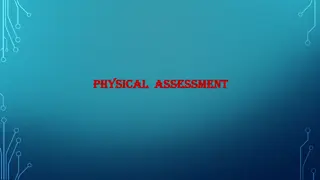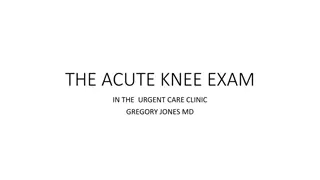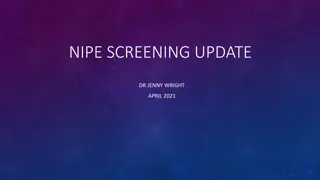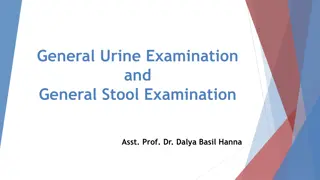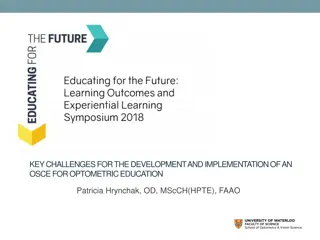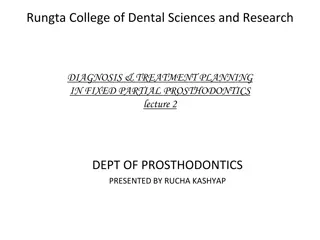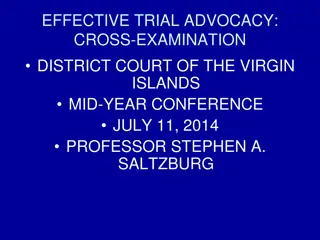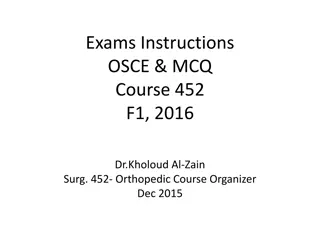MRCS Part B OSCE Examination Guidelines
The MRCS Part B OSCE examination guidelines provide crucial information for candidates, including rules regarding electronic devices, station structures, timing of stations, and specific timings for different types of stations. Candidates must adhere to the regulations, follow station-specific timings, and be prepared to move swiftly between stations. Failure to comply with the guidelines may result in misconduct.
Download Presentation

Please find below an Image/Link to download the presentation.
The content on the website is provided AS IS for your information and personal use only. It may not be sold, licensed, or shared on other websites without obtaining consent from the author.If you encounter any issues during the download, it is possible that the publisher has removed the file from their server.
You are allowed to download the files provided on this website for personal or commercial use, subject to the condition that they are used lawfully. All files are the property of their respective owners.
The content on the website is provided AS IS for your information and personal use only. It may not be sold, licensed, or shared on other websites without obtaining consent from the author.
E N D
Presentation Transcript
MRCS Part B OSCE Candidate Briefing
Important information Mobile phones and electronic devices are not permitted in the examination. If you have not done so already please hand over any devices to the Registration Administrator You should not have any pieces of paper with you during the examination. In stations with a preparation bay you are allowed to make notes to take into the question bay, but these notes must be left in the question bay. There is no need to have any paper with you for any other part of the OSCE circuit You are reminded that seeking to gain prior knowledge from, or provide knowledge to, other examination candidates, on the content of the examination, is deemed as misconduct and will be dealt with appropriately. This includes communicating using social media, internet message boards, and chat groups etc.
Structure of the exam circuits Stations have been divided into 2 circuits Interval of 15-20 minutes between each circuit. Exam conditions apply during the interval and you may not leave the designated areas during this time Member of the examination team will guide you around the circuit, including to your starting station and between the two circuits. Candidates who commence with a preparation station will start the examination 10 minutes before the other candidates With the examined stations, the preparation stations and the rest stations the total number of stations will be about 20 The circuit moves in a clockwise direction
Timing of the stations Each station is 10 minutes long: 1 minute reading the instructions outside the station and 9 minutes in the station itself. When the end of a station is indicated you should move swiftly to the next station. You will have a minute to do this and should wait with your back to the instructions outside the next station until instructed to begin reading them. If you finish a station early you must stay in the station until the end of the 9 minutes; the examiner will not talk to you during this time
Station-specific timings In physical examination and history-taking stations, you will have 6 minutes to carry out an examination of/take a history from a patient - You will receive a signal after 6 minutes. At this point you should present your findings. If you are ready to present your findings before 6 minutes, let the examiner know - Please note that it is possible you will hear a signal after 6 minutes even if you are not in a physical examination or history taking station The two giving and receiving information stations will have a 9-minute preparation station immediately before them. Candidates who start with a preparation station will start the examination 10 minutes before the other candidates - In the giving and receiving information stations, you should assume the scenario is taking place on the date that has been specified in bold and underlined in the clinical notes folder and you should assume, for the purpose of the station, that this is today s date
Actors, simulated patients, real patients & examiners Actors and simulated patients will be used in some stations. They are trained to simulate a particular situation or medical issue for the purposes of the scenario Real patients are used in some physical examination stations. They will have the actual medical issue described in the scenario Please note that it is possible that the patients used in the exam may have an assistance dog with them in the exam bay Some stations will feature two examiners; one of these will be a Lay examiner who will be assessing your communication skills and will not ask you any questions
iPads and other tablet devices This examination uses iPads for the purpose of viewing radiological images only - In the event of a problem please notify the examiner in your station. If a problem does arise a hard copy of the image will be made available to you - All functions of the iPad have been disabled so that you are only able to navigate the image(s) on the screen and use the zoom function - Any candidate caught tampering with any other function on the iPad will have their results withheld pending investigation
Further Information Your candidate number badge must be worn at chest height and not clipped to waistbands All candidates must comply with the dress code described in the Instructions to Candidates and Regulations Hand gel must be used at clinical bays Water will be available at various points in the examination hall If you require a comfort break, please inform a member of staff who will escort you to the toilets. A comfort break can only be taken during a rest bay and in the interval at the halfway point
End of the exam Cycle 1 candidates must regroup in the designated waiting area after the examination. You will remain under examination conditions and will be given a time whereby you may leave the building. This will be at the start of the afternoon session. You must not leave the venue until advised to do so. A member of staff will be in the room to ensure exam conditions are maintained A light lunch shall be provided for candidates during this time Cycle 2 candidates must remain at the venue until all marks are in and you are advised by a member of staff that you can leave
Evaluation Evaluation forms will be handed out at the end of the examination and we would appreciate if you could take the time to complete the form The Supervising Examiner and Assessor will also meet with you after the examination for an informal discussion and you will have an opportunity to give your views at this time
Fire alarm evacuation In the event that the fire alarm sounds: - Follow staff instructions - Leave with examiner - Do not interact with other candidates - Do not discuss the exam - The candidate in the phone bay should stay with the invigilator The exam will restart at the beginning of the last station if possible
Assessors Role of assessor Intercollegiate & independent of Royal Colleges Take no part in assessment of candidates Assess all aspects of the MRCS Debrief at end of exam (private)
How we behave at each station Will be there as you arrive We will keep out of your way Ask to see final marks Leave station after you
Anti clockwise route May meet a candidate more than once Many candidates will not see an assessor Video observation (not recording) may be in use











